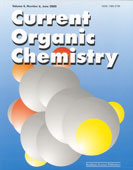"Synthesis and Application of New N-Heterocyclic Carbene Ruthenium Complexes in Catalysis: A Case Study"
Lionel Delaude, Albert Demonceau, and Alfred F. Noels
 |
source: Current Organic Chemistry
year: 2006
volume: 10
first page: 203
last page: 215
doi: 10.2174/138527206775192924
|
Abstract: New imidazolium and imidazolinium salts were synthesized and their ability to act as stable N-heterocyclic carbene (NHC) ligand precursors was investigated in various ruthenium-catalyzed processes. Thus, 1,3-diarylimidazol(in)ium chlorides bearing the phenyl, 1-naphtyl, 4-biphenyl, 3,5-dimethylphenyl, 2-tolyl, 2,6-dimethylphenyl, 2,4,6-trimethylphenyl (mesityl), and 2,6-diisopropylphenyl substituents were prepared. They were combined with the [RuCl2(p-cymene)]2 dimer and potassium tert-butoxide or sodium hydride to generate the corresponding ruthenium-arene complexes [RuCl2(p-cymene)(NHC)] in situ. The catalytic activity of all these species was investigated in the photoinduced ring-opening metathesis polymerization (ROMP) of norbornene and cyclooctene. Results from this study showed that the C4-C5 double bond in the imidazole ring of the NHC ligands was not crucial to achieve high catalytic efficiencies. The presence or the absence of alkyl groups on the ortho positions of the phenyl rings had a more pronounced influence. Blocking all the ortho positions was a requisite for obtaining efficient catalysts. Failure to do so probably resulted in the ortho-metallation of the carbene ligand, thereby altering the coordination sphere of the ruthenium active centers. Catalytic screenings were also carried out with the various imidazol(in)ium salts to evaluate their ability at promoting the cyclopropanation of styrene and cyclooctene with ethyl diazoacetate. Under the experimental conditions adopted, the exact nature of the N,N'-diaryl groups had very little influence on the outcome of these reactions. The imidazolium salts were further probed as catalyst modifiers for the Atom Transfer Radical Addition (ATRA) of carbon tetrachloride to styrene. Some species displayed a dual activity and promoted both olefin metathesis and ATRA.
Keywords: Arene, Atom Transfer Radical Addition, Cyclopropanation, Imidazolinium, Imidazolium, Kharasch Addition, Olefin Metathesis, Ring-Opening-Metathesis Polymerization
[Full Text] [<< Previous Article] [Back to the List of Publications] [Next Article >>] l.delaude@ulg.ac.be